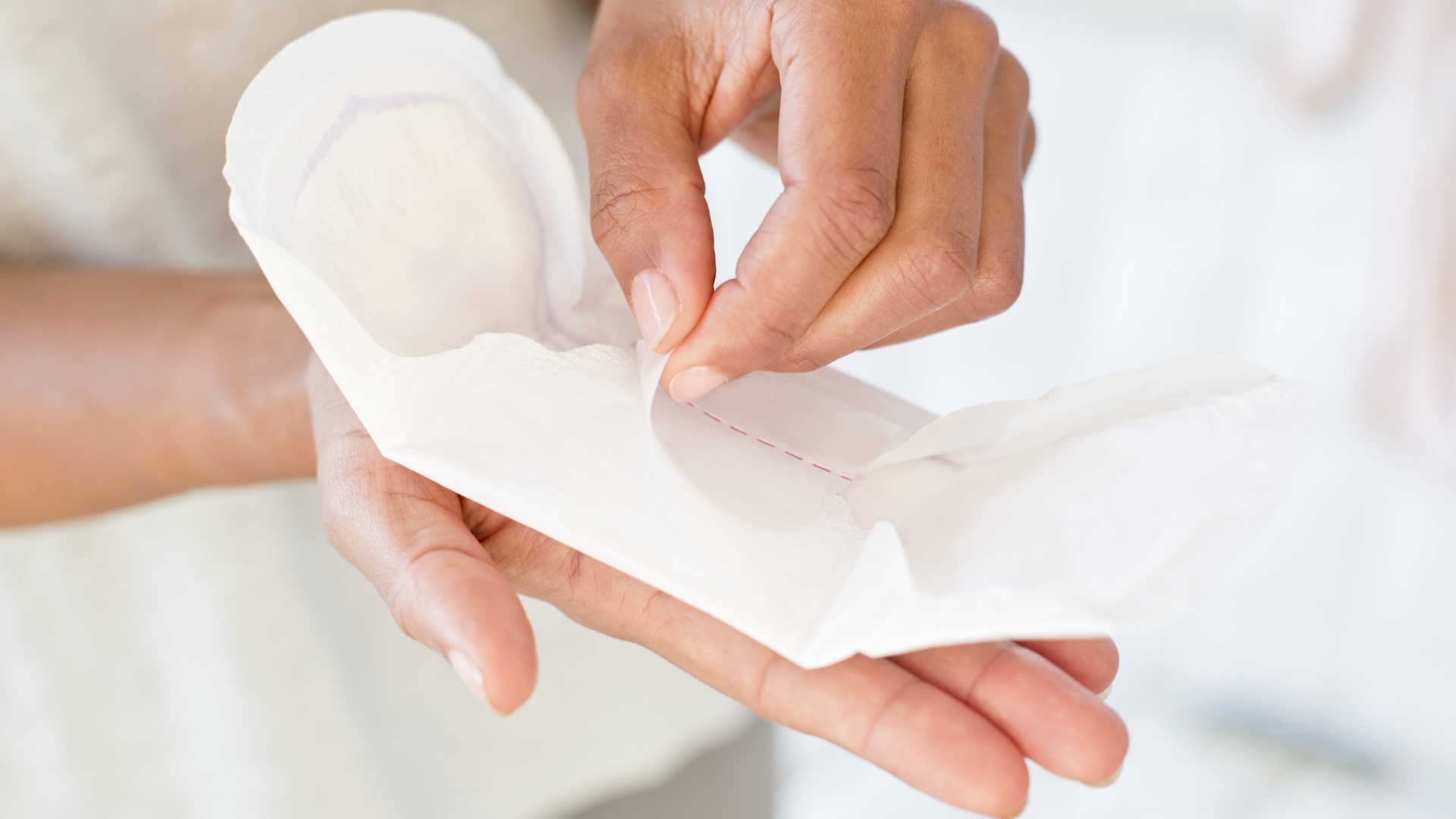New menstrual pad device tracks period blood for signs of disease
Scientists are developing a new device that fits inside a menstrual pad and checks for "biomarkers" of disease in period blood.

Scientists have unveiled a new device that can be incorporated into menstrual pads and may someday be helpful for screening for diseases like ovarian cancer.
The light-weight device looks for disease biomarkers — in this case, measurable levels of specific proteins — in menstrual blood. It includes a paper test strip that changes color when it's exposed to biomarkers of interest.
"We imagine this tool to be potentially useful for women at increased risk for cancer," said Inge Herrmann, a professor and leader of the Nanoparticle Systems Engineering Lab at ETH Zurich. She told Live Science that she hopes that the technology may "provide users with an additional monitoring tool" that's cost effective.
Herrmann and her colleagues authored a study about the device that was published in May in the journal Advanced Science. It has so far been tested with blood from healthy volunteers, so it needs further testing before it can be rolled out as a screening tool.
How the device works
The device, which measures about an inch squared (2 by 2 centimeters) and is encased in a soft silicone, sits at the bottom of the menstrual pad. The silicone encases the test strip that changes color when exposed to specific proteins. If a biomarker is present, either a line or a circle appears within about 15 minutes of exposure; the darker the color, the more protein is present.
The researchers say these results can be read by eye, but they have also developed an app that uses a machine learning-driven image analysis to interpret the test. The pad the device is embedded in can be worn for as long as a regular menstrual pads, and as for the device itself, "you can't feel it," Herrmann said.
Related: New blood test detects ovarian cancer years before conventional methods
Get the world’s most fascinating discoveries delivered straight to your inbox.
The researchers made their initial prototype sensitive to three biomarkers: C-reactive protein (CRP), a marker of inflammation; carcinoembryonic antigen (CEA), a "tumor maker" associated with various cancers; and cancer antigen-125 (CA-125), which is specifically associated with ovarian cancer.
Blood tests exist for all three of these biomarkers: CRP tests monitor inflammation in the body. CEA tests are used to assess how advanced a cancer is or whether treatment is working, but are not used for screening. CA-125 tests can be used to screen for ovarian cancer in people at high risk of the disease, but aren't used for people at average risk because high concentrations can be due to other conditions, including endometriosis.
One draw of the new device is that it would be easy for patients to use and less invasive than these existing blood tests, said Dr. Paul Blumenthal, a professor emeritus in obstetrics and gynecology at Stanford University. Blumenthal was not involved in the new study but has conducted similar research on the clinical potential of menstrual blood.
To test the device, the researchers ran tests with venous blood and menstrual blood donated by volunteers to see if it detected similar biomarker concentrations in both types of blood. This included tests in which the scientists "spiked" blood samples with the biomarkers of interest, so they knew exactly how much should be in there.
They compared the device's findings with the expected concentrations and also checked its work by assessing those concentrations with clinical chemistry. "There was always good agreement" among these assessments, Herrmann said.
Additionally, they had volunteers wear the device while on their periods. These individuals reported that, in terms of comfort and wearability, there was "no difference compared to a commercially available sanitary pad."
Next steps
Blumenthal says such a tool has clinical potential.
Considering ovarian cancer as an example, the Centers for Disease Control and Prevention notes that there's "no reliable way to screen for ovarian cancer in women who do not have any symptoms." And early symptoms of the disease are similar to those seen during a typical menstrual cycle, such as bloating and lower back pain.
Blumenthal suggested that monitoring CA-125 regularly over time could be a promising way to watch for the disease. "Year after year, let's just say I'm measuring your CA-125, and it's pretty normal," he said. "And one year it sneaks above your level — maybe that's the first indication [that] something is not right."
Related: Scientists invent 1st 'vagina-on-a-chip'
Herrmann also sees the technology as a potential screening tool — a sort of "early warning" detection system particularly for women at a higher genetic risk of cancer.
That said, one possible issue with the device is that excess blood could get onto the test strip and make its results unreadable, Herrmann said. She also noted that this technology comes with a risk of creating "a lot of stress for users, when an app tells them that there's some deviation, and that they might come to the conclusion that it's cancer." That's a concern that should be taken into account with all tech intended to be used for self-monitoring, she noted.
The next step is for researchers to recruit people to use the pad in "real world" conditions and investigate whether it really can provide a medical benefit, Herrmann said. They're now looking to recruit about 100 people for the next round of testing. Depending on how the lab's upcoming research goes and how the product is ultimately regulated, Herrmann believes that it could be available in about three years.
This article is for informational purposes only and is not meant to offer medical advice.

Rachel Somerstein is the author of "Invisible Labor: The Untold Story of the Cesarean Section" (Ecco, 2024), which is now out in paperback. Her work on maternal health has also appeared in the Guardian, the 19th, and Women's Health, among other outlets. She holds a PhD in mass communications from Syracuse University and is an associate professor of journalism at SUNY New Paltz.
You must confirm your public display name before commenting
Please logout and then login again, you will then be prompted to enter your display name.


